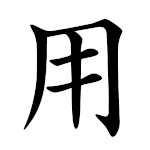| 用 | ||
|---|---|---|
| ||
| 用 (U+7528) "use" | ||
| Pronunciations | ||
| Pinyin: | yòng | |
| Bopomofo: | ㄩㄥˋ | |
| Wade–Giles: | yung4 | |
| Cantonese Yale: | yung6 | |
| Jyutping: | jung6 | |
| Japanese Kana: | ヨウ yō / ユウ yū (on'yomi) もち-いる mochiiru (kun'yomi) | |
| Sino-Korean: | 용 yong | |
| Names | ||
| Japanese name(s): | 用/もちいる mochiiru | |
| Hangul: | 쓸 sseul | |
| Stroke order animation | ||
 | ||
Radical 101 or radical use (用部) meaning "use" is one of the 23 Kangxi radicals (214 radicals in total) composed of 5 strokes.
In the Kangxi Dictionary, there are 10 characters (out of 49,030) to be found under this radical.[1]
Evolution
 Oracle bone script character
Oracle bone script character Bronze script character
Bronze script character Large seal script character
Large seal script character Small seal script character
Small seal script character
Derived characters
| Strokes | Characters |
|---|---|
| +0 | 用 甩 |
| +1 | 甪 |
| +2 | 甫 甬 |
| +4 | 甭 甮 |
| +7 | 甯 (=寧 -> 宀) |
Sinogram
The radical is also used as an independent Chinese character. It is one of the Kyōiku kanji or Kanji taught in elementary school in Japan.[2] It is a second grade kanji[2]
References
- ↑ "Unihan data for U+7528". Unicode Consortium. Retrieved 26 March 2011.
- 1 2 "The Kyoiku Kanji (教育漢字) - Kanshudo". www.kanshudo.com. Archived from the original on March 24, 2022. Retrieved 2023-05-06.
Literature
- Fazzioli, Edoardo (1987). Chinese calligraphy : from pictograph to ideogram : the history of 214 essential Chinese/Japanese characters. calligraphy by Rebecca Hon Ko. New York: Abbeville Press. ISBN 0-89659-774-1.
- Lunde, Ken (Jan 5, 2009). "Appendix J: Japanese Character Sets" (PDF). CJKV Information Processing: Chinese, Japanese, Korean & Vietnamese Computing (Second ed.). Sebastopol, Calif.: O'Reilly Media. ISBN 978-0-596-51447-1.
Wikimedia Commons has media related to Radical 101.
This article is issued from Wikipedia. The text is licensed under Creative Commons - Attribution - Sharealike. Additional terms may apply for the media files.